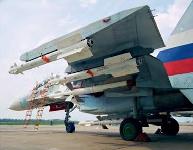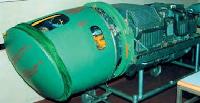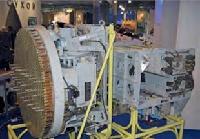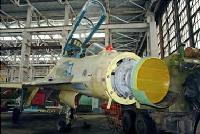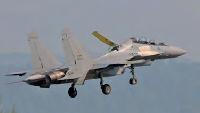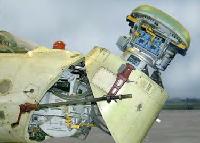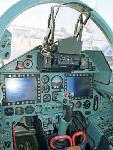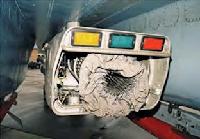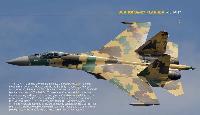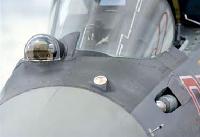Фотографии
-
Регистрационный номер: RF-92211 Russian Air Force Su-27SM RF-92211 was upgraded in 2002 - 2003 and now serves at Lipetsk with the evaluation and crew conversion centre.
Самолёты на фотографии: Сухой Су-27 - Россия - 1981
-
Регистрационный номер: RF-92407 Su-27 RF-92407 from the 790th IAP based at Khotilovo Air Base during an intercept by an RAF Typhoon over the Baltic Sea in 2014.
Самолёты на фотографии: Сухой Су-27 - Россия - 1981
-
Регистрационный номер: TS-2705, TS-3005 В дополнение к своим девяти ударным истребителям Су-30МК/МК2 Индонезия с 2003 года получила еще пару Су-27СК и три Су-27СКМ. На снимке: четыре Су-27СК/СКМ в одном строю с парой австралийских F/A-18A Hornet во время совместных учений в 2012 году.
Su-27SKM TS-2705 is one of three such aircraft unique to the Tentara Nasional Indonesia-Angkatan Udara; all were delivered in 2010.Самолёты на фотографии: McDonnell Douglas F/A-18A Hornet - США - 1978Сухой Су-27 - Россия - 1981Сухой Су-30 - Россия - 1988
-
The R-27R semi-active radar-guided long-range air-to-air missile is one type of a family developed especially for the Su-27 and MiG-29 fighters.
Самолёты на фотографии: Сухой Су-27 - Россия - 1981
-
Upgraded Russian Air Force Su-27SM(3) fighters assigned to the Lipetsk evaluation centre.
Самолёты на фотографии: Сухой Су-27 - Россия - 1981
-
Sukhoi development Su-27SKM, side number 305, drops two 500kg (1,100lb) KAB-500Kr TV-guided bombs.
Самолёты на фотографии: Сухой Су-27 - Россия - 1981
-
Aircraft T10S-3 (P-42) was stripped of most of its equipment and paint to reduce weight for its record-breaking flights.
Самолёты на фотографии: Сухой Су-27 - Россия - 1981
-
Ukrainian Air Force Su-27, side number 100, received a digital colour scheme in 2012.
Самолёты на фотографии: Сухой Су-27 - Россия - 1981
-
30mm rounds being loaded in to the Su-27’s Gryazev-Shipunov GSh-301 cannon fitted in the starboard leading-edge root extension.
Самолёты на фотографии: Сухой Су-27 - Россия - 1981
-
Aircraft T10-20R was prepared for a range of record flights with fuel tanks fitted in the nose and tail beam, and ogive ends attached to the wings. The record-breaking flights were eventually abandoned.
Самолёты на фотографии: Сухой Су-27 - Россия - 1981
-
The R-27T differs from the R-27R with the passive infrared Geophisica 36T seeker in that it has no mid-course path correction and tracks only after the target is locked on by the seeker.
Самолёты на фотографии: Сухой Су-27 - Россия - 1981
-
Lyulka-Saturn’s AL-31F turbofan engine is the powerplant of all Su-27 and Su-30 versions.
Самолёты на фотографии: Сухой Су-27 - Россия - 1981
-
Short-range R-73s and long-range R-27s on a Su-27 at the Lipetsk evaluation centre.
Самолёты на фотографии: Сухой Су-27 - Россия - 1981
-
The conventional Cassegrain-antenna N001 radar is fitted to standard Su-27, Su-33 and Komsomolsk-made Su-30 fighters.
Самолёты на фотографии: Сухой Су-27 - Россия - 1981
-
Thanks to a combination of gas and aerodynamic controls, the R-73 is one of the world’s best short-range air-to-air missiles. The laser fuse of the R-73L is recognisable by rectangular windows positioned aft of the front fins.
Самолёты на фотографии: Сухой Су-27 - Россия - 1981
-
Опытный Т-10-17 (второй серийный самолет новой компоновки) с типичными для первых Т-10С килями, имеющими горизонтально обрезанные законцовки.
T10-17 was the first production Su-27 in T-10S configuration that first flew at Komsomolsk on June 2, 1982.Самолёты на фотографии: Сухой Су-27 - Россия - 1981
-
Регистрационный номер: RF-90746 A Su-27 with its airbrake deployed atop the fuselage.
Самолёты на фотографии: Сухой Су-27 - Россия - 1981
-
On February 7, 1987, a pair of Su-27s were encountered by a Western aircraft, two Royal Norwegian Air Force F-16s over the Barents Sea, for the first time. On September 13, 1987, a mid-air collision occurred between a Soviet Air Force Su-27 and a Royal Norwegian Air Force P-3 Orion patrol aircraft. The P-3 was intercepted at 10.39hrs by the Su-27, flown by Vasily Tsimbal assigned to the 941st IAP, over international waters, 90km (48nm) from the coast of the USSR during a patrol in an area where Soviet warships were on exercise. To block out the Orion’s reconnaissance equipment the Soviet Su-27 flew beneath its belly. The propeller of the Orion’s outer starboard engine hit the Su-27’s fin. Fortunately, both aircraft returned to their bases.
Самолёты на фотографии: Сухой Су-27 - Россия - 1981
-
Central to the Su-27's cockpit is the ILS-31 head-up display; on the right is the IPV tactical situation display, with the navigation device required for international flights above.
Самолёты на фотографии: Сухой Су-27 - Россия - 1981
-
Su-30 502 is a Sukhoi test aircraft based at Komsomolsk used for the development of versions of the Su-30MK.
Самолёты на фотографии: Сухой Су-30 - Россия - 1988
-
На снимке запечатлен пуск ракеты Х-29 во время испытаний опытного Су-30МК. Ракета может оснащаться пассивной телевизионной (Х-29Т) или полуактивной лазерной (Х-29Л) ГСН.
Su-30MK2, side number 503, launches a Kh-29L laser-guided missile.Самолёты на фотографии: Сухой Су-30 - Россия - 1988
-
Once all contracts are fulfilled, Russia will have ten Su-30SM squadrons making it the most numerous fighter in the Russian Air Force fleet.
Самолёты на фотографии: Сухой Су-30 - Россия - 1988
-
As of January 2017, the Indian Air Force had received 233 Su-30MKI fighters, including 50 delivered in flyaway condition from Irkutsk in Russia.
Самолёты на фотографии: Сухой Су-30 - Россия - 1988
-
Since September 2015, four Su-30SM fighters are deployed to Syria to provide air cover to the Russian Air Group.
Самолёты на фотографии: Сухой Су-30 - Россия - 1988
-
Ракета Х-59М оснащена маршевым малогабаритным ТРДД, подвешенным в гондоле снизу, а ее наведение осуществляется при помощи аппаратуры, размещенной в универсальном подвесном контейнере АПК-8 или АПК-9.
In 2004, a Su-30MK2 dropped a Kh-59M2A anti-ship missile that reached a range of 285km.Самолёты на фотографии: Сухой Су-30 - Россия - 1988
-
Регистрационный номер: RF-96521 Su-30M2s serve as combat trainers in units equipped with upgraded Su-27SMs. Russian Air Force Su-30M2 RF-96521, 10 Red is assigned to the 3rd Composite Aviation Regiment at Krymsk.
Самолёты на фотографии: Сухой Су-30 - Россия - 1988
-
Su-30MK2V 5812, assigned to Grupo Aereo de Caza 13 of the Aviacion Militar Bolivariana, is one of 24 received by Venezuela between 2006 and 2008.
Самолёты на фотографии: Сухой Су-30 - Россия - 1988
-
The NIIP N011M Bars electronically scanned array radar features three rows of small T-shaped antennas in the centre for the IFF.
Самолёты на фотографии: Сухой Су-30 - Россия - 1988
-
An Irbis radar during tests on a Su-30.
Самолёты на фотографии: Сухой Су-30 - Россия - 1988
-
One of 18 Su-30MKMs delivered to Malaysia in 2007-2009 feature French and Russian-made systems instead of Israeli ones as used in Indian Su-30MKIs.
Самолёты на фотографии: Сухой Су-30 - Россия - 1988
-
Su-30MK2V 1168 of the Aviacion Militar Bolivariana.
Самолёты на фотографии: Сухой Су-30 - Россия - 1988
-
An N135 Irbis radar for the Su-35 during tests on Su-30MK, side number 503 test aircraft in 2007.
Самолёты на фотографии: Сухой Су-30 - Россия - 1988
-
Регистрационный номер: M52-11 The Su-30MKI and its derivatives, like this Su-30MKM, are the most successful Russian fighter types of the post-Soviet period. By February 2017, Irkut had delivered 390 aircraft from an order book for 475.
Самолёты на фотографии: Сухой Су-30 - Россия - 1988
-
The front cockpit of a Su-30MKK with two 150 x 200mm (6x8 inch) MFI-10-5 multifunction displays, an ILS-31 head-up display and a set of conventional standby instruments.
Самолёты на фотографии: Сухой Су-30 - Россия - 1988
-
Su-33s on the flight deck of the carrier Admiral Kuznetsov.
Самолёты на фотографии: Сухой Су-27К / Су-33 - Россия - 1985
-
A rare weapon configuration under the folded wing of a Su-33 comprising two S-250FM unguided rockets on a twin pylon and an R-73 air-to-air missile and Sorbtsiya electronic countermeasures pod above.
Самолёты на фотографии: Сухой Су-27К / Су-33 - Россия - 1985
-
Su-27K T10K-1, side number 37, was the first one built and made its maiden flight on August 17, 1987.
Самолёты на фотографии: Сухой Су-27К / Су-33 - Россия - 1985
-
The UPAZ-1K refuelling pod fitted under a Su-33 enables fuel transfer to another aircraft at a rate of 2,300 litres per minute.
Самолёты на фотографии: Сухой Су-27К / Су-33 - Россия - 1985
-
The UPAZ-1K refuelling pod features three coloured lights for signalling to the pilot of the receiver aircraft.
Самолёты на фотографии: Сухой Су-27К / Су-33 - Россия - 1985
-
Самолёты на фотографии: Сухой Су-35 - Россия - 1988
-
Регистрационный номер: RF-95477 Russian Air Force Su-35S RF-95477, Red 54 lands at Kubinka Air Base.
Самолёты на фотографии: Сухой Су-35 - Россия - 1988
-
Su-35C 02 Red, one of the first batch of 12 delivered to the Russian Air Force in February 2014 and now operational at Dzyomgi Air Base.
Самолёты на фотографии: Сухой Су-35 - Россия - 1988
-
The AL-41F1S engine powers the latest Su-35.
Самолёты на фотографии: Сухой Су-35 - Россия - 1988
-
The most modern member of the Flanker family is the Su-35S, intended as a low-cost complementary fighter to the T-50 PAK FA, along with its Su-30SM and Su-30M2 fleets.
Самолёты на фотографии: Сухой Су-35 - Россия - 1988
-
The first Su-35S for the Russian Air Force during tests with Kh-31 air-to-surface and R-73 air-to-air missiles. Note the freefall bombs loaded on pylons between the engines.
Самолёты на фотографии: Сухой Су-35 - Россия - 1988
-
Twelve Su-27M fighters, side numbers 701 to 712, were built between 1988 and 1994, and assigned to trials. Aircraft 709 was displayed at air shows with the Su-35 export designation.
Самолёты на фотографии: Сухой Су-35 - Россия - 1988
-
The first Su-35 prototype, side number 901, was used for initial testing and lacks a fire-control system.
Самолёты на фотографии: Сухой Су-35 - Россия - 1988
-
The upper forward fuselage of the Su-35 houses sensors for the OLS-35 IRST (left); the SOER missile approach warning system (middle); and the air refuelling probe (right), all mounted forward of the cockpit canopy.
Самолёты на фотографии: Сухой Су-35 - Россия - 1988
-
In 2002, thrust-vectoring AL-31FP engines were fitted on the Su-27KUB.
Самолёты на фотографии: Сухой Су-27КУБ / Су-33УБ - Россия - 1999
-
Su-27UB trainer 74 assigned to the 831 st Tactical Aviation Brigade of the Ukrainian Air Force.
Самолёты на фотографии: Сухой Су-27УБ - Россия - 1985
-
Upgraded Belarussian Air Force Su-27UBM1 side number 63. This aircraft crashed during a demonstration at Radom Air Base, Poland, in August 2009.
Самолёты на фотографии: Сухой Су-27УБ - Россия - 1985
-
The first T-10 prototype T10-1 was first flown on May 20, 1977, by Sukhoi’s chief test pilot Vladimir Ilyushin.
Самолёты на фотографии: Сухой Т-10 - Россия - 1977












